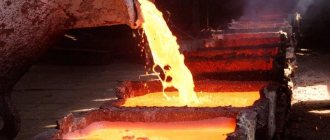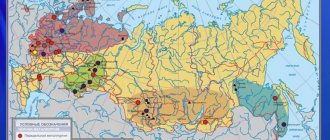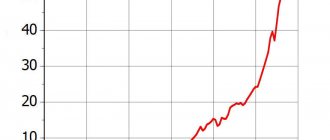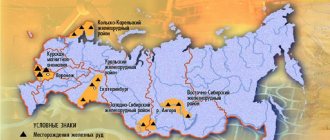Industrial sectors of the Urals
The sectors of market specialization of the Ural economic region are the mining industry, ferrous and non-ferrous metallurgy, mechanical engineering, chemical and petrochemical, forestry, woodworking and pulp and paper industries .
The production of building materials (cement, building bricks, etc.) is also important. The Urals produces from 20 to 40% of the all-Russian output of metal-cutting machines, excavators, oil equipment, chemical equipment and machinery for agriculture, over 35% of cast iron, about 15% of industrial wood and lumber, and almost 20% of paper.
The fuel industry, electric power industry, food and light industry, as well as agriculture complement the economic complex of the Urals.
A significant influence on the formation of the economy of the Ural economic region is exerted by its extremely favorable economic and geographical location. The Urals occupies a central position in the country. It is part of the Western Economic Zone of Russia, borders the regions of the Eastern Zone, hence the relative proximity to a variety of mineral, raw materials and fuel and energy resources of Siberia, to markets for finished products that are consumed in both the western and eastern regions of the country.
The Urals are important as a machine-building base for the development of the eastern regions. The favorable economic and geographical position of the Urals contributes to increasing its role in the interregional territorial division of labor.
Energy of the Urals
The integrated energy system of the Urals includes nine regional energy systems. The complex consists of about 220 power plants and more than 1,550 substations. The total length of power lines is about 126 thousand kilometers.
The region's unified energy system has high maneuverability of block equipment. It is this technology that allows, if necessary, to change the total load of power plants and turn off the reserve for certain days.
History of development
The economic prosperity of the Urals began back in 1721 by decree of Emperor Peter I. It was he who approved the initiative of V.N. Tatishchev, and on the banks of the Iset River they founded the largest ironworks and fortress in Russia. Since then, the importance of the Urals for Russia has only increased.
At the end of the 17th - beginning of the 18th centuries. The construction of iron and iron smelting plants began. At that time, the Urals supplied iron not only to Russia, but also to Western Europe. But gradually the Ural industry fell into decay. This was due to the remnants of serfdom, the enslaving position of the Ural workers, the technical backwardness of the Urals, isolation from the center of Russia, and competition from southern metallurgy. As forests were cut down, more and more Ural factories were closed. During the First World War, the tsarist government made an attempt to revive the Ural metallurgy, but was not successful.
In addition to ferrous metallurgy, the smelting of copper, platinum and gold mining were of some importance in the industry of the pre-revolutionary Urals. Mechanical engineering was poorly developed. The production of simple machines and equipment predominated: plows in Chelyabinsk, tools in Zlatoust, various metal products at Kusinsky, Nyazepetrovsky and other factories. The largest of the machine-building plants were Motvilikha, Botkinsky, and Ust-Katavsky.
In the 1930s, the creation of a large Ural metallurgy, the development of mechanical engineering, chemical, paper and forestry industries began in the Urals. Much work has been carried out to create a fuel and energy base. To supply electricity to the industry of the Urals, construction was carried out on the basis of local fuel at the Chelyabinsk, Egorshinskaya, Kizelovskaya and other power plants, and later at the Beloyarsk NPP, Reftinskaya, Permskaya, Iriklinskaya State District Power Plants, etc.
The largest metallurgical enterprises were built in the Urals, such as the Magnitogorsk Iron and Steel Works, the Chelyabinsk Metallurgical and Electrometallurgical Plants and many others. Chusovskaya, Serovsky, Zlatoustovsky and a number of other plants underwent radical reconstruction, which became the country's leading enterprises in the smelting of high-quality steel for the needs of the aviation, automotive and tool industries. A large machine-building base was created.
The production of chemical products, in particular sulfuric acid, potash fertilizers, etc., has increased significantly. The forestry, woodworking, and pulp and paper industries have developed greatly. The light and food industries began to develop.
Magnitogorsk plant
The Ural metallurgical base is represented by a fairly large number of enterprises. The Magnitogorsk plant is not only the largest in Russia, but also in Europe. It was built in the 30s of the last century. The production premises of the Magnitogorsk plant occupy a total of about 7,000 hectares. This enterprise produces 20% of all products sold on the Russian market and has a full operating cycle. The first stage of production at the plant is the extraction of ores, and the last is the deep processing of ferrous metal. About 40% of all products produced by this enterprise are exported.
Branches of market specialization of industry
The leading industry of market specialization in the Urals is ferrous metallurgy. The Urals are the main metallurgical base of Russia. More than 80% of the metal is produced by factories and combines - Magnitogorsk, Chelyabinsk, Nizhny Tagil and Orsko-Khalilovsky. Of the old reconstructed factories, the most significant are the Zlatoust, Verkh-Isetsky, Lysvensky, Chusovskoy, and Beloyarsky plants. Full-cycle plants operate partly on local iron ores, ores from the KMA and neighboring Kazakhstan, and on imported coking coals from Kuzbass.
At metallurgical plants in blast furnace and steel production, natural and coke oven gases are widely used as fuel. The presence of alloying additives in the iron ores of the Urals makes it possible to smelt high-quality metal. In addition to ferrous metals, some alloying metals are also smelted in the region - vanadium, titanium, nickel.
Ferroalloys are produced in Chelyabinsk, Serov and the Chusovsky plant. Ferrous metallurgy waste is used to produce construction materials and chemical products. Metallurgical slags are used as fertilizer and building materials.
The largest ferrous metallurgy enterprises in the Urals
Most of the factories in this region are full-cycle industries. The largest ones include Magnitogorsk, Novotroitsk, Chelyabinsk and Nizhny Tagil. These four enterprises produce 80% of all the region's pig iron and 70% of its steel. There are other plants in this region, not so large: in Serov, Chusovo, Beloretsk, Alapaevka, etc. The largest iron ore deposit in the Urals is Kachkanarskoye. The second most important is Orsko-Khalilovskoye. Almost all Russian chromites are mined here.
Non-ferrous metallurgy
Non-ferrous metallurgy is of national importance. The old branches of non-ferrous metallurgy include the copper smelting industry. The region is one of the leading places in the country in copper smelting. Copper smelters are located near copper deposits on the eastern slopes of the Ural Mountains.
Many factories were built before the revolution and were radically reconstructed during the Soviet period. The largest of them:
- Kyshtym copper electrolyte plant.
- Karabash copper-electrolyte plant in the Chelyabinsk region.
- Kirovograd copper smelter in the Sverdlovsk region.
New enterprises were created:
- Mednogorsk (Orenburg region) and Krasnouralsk plants.
- Sred-Neuralsky plant (Sverdlovsk region).
- A large Gai mining and processing plant operates on the basis of the Gai copper ore deposit.
Most copper smelters specialize in smelting blister copper . In Verkhnyaya Pyshma near Yekaterinburg there is a large plant producing refined copper. The copper industry in the Urals is usually associated with the chemical industry producing sulfuric acid and superphosphate.
The Urals occupy a leading place in the production of alumina and aluminum. The main centers of the aluminum industry : Kamensk-Uralsky and Krasnoturinsk (Sverdlovsk region). The Urals supplies a significant amount of alumina to other regions of the country. Cryolite production is associated with the aluminum industry, represented by the Kuvandyk (Orenburg region) and Polevsky (Sverdlovsk region) plants.
The nickel industry is represented by the Yuzhnouralsk plant in Orsk (Orenburg region) and the Ufaleysky plant (Chelyabinsk region). Magnesium production is developed in Solikamsk and Berezniki (Perm region). Processing of non-ferrous metals, production of foil, pipes, and castings from them are carried out in Orsk, Kamensk-Uralsky, Mikhailovsk (Sverdlovsk region).
Metallurgy of the Urals
The metallurgical industry of the Urals is one of the oldest industries, which was formed on the basis of a good local raw material base. Modern enterprises continue to develop and increase the volume of products produced. Old factories have been reconstructed and continue to operate.
Some enterprises have established the production of pipes and ferroalloys. More than 50% of iron ores for the metallurgical industry are supplied from the Magnitogorsk, Goroblagodatskoye and Pervouralskoye deposits. All major areas of non-ferrous metallurgy operate in the Urals.
Mechanical engineering and metalworking
The sectors of market specialization of the Urals are also mechanical engineering and metalworking . Among them are such giants as the Ural Heavy Engineering Plant in Yekaterinburg (Uralmash) and the Chelyabinsk Tractor Plant. Ekaterinburg Electrical Equipment Plant, Chelyabinsk Abrasive Plant and a number of others. Old factories have also been reconstructed, including the Zlatoust instrumental plant. Chelyabinsk Agricultural Engineering Plant, Miass Plant, etc.
Characteristic of the intra-regional location of the Ural machine-building and metalworking industry is the formation of four largest centers:
- Center for heavy engineering and electrical engineering in Yekaterinburg.
- Center for Heavy Engineering in Nizhny Tagil.
- Center for tractor manufacturing and agricultural engineering in Chelyabinsk.
- Center for diversified mechanical engineering and shipbuilding in Perm.
Over 70% of the entire Ural mechanical engineering capacity is concentrated in these centers. The Sverdlovsk region occupies a leading place in the development of this industry in the Urals.
Mechanical engineering in the Urals received great development during the Great Patriotic War and in the post-war period. It has risen to a high level in structure and specialization and has become more qualified. New industries emerged: automobile manufacturing, engine manufacturing, ball bearing production, a number of electrical engineering branches, power engineering and machine tool building. The tool industry has expanded significantly.
Problems and development prospects
The geographical position of the Ural metallurgical base is quite favorable. But, unfortunately, even despite a number of recent reforms, the Urals remains a region that exports mainly only unprocessed products. Analysts see the most promising direction in the development of industry in the region as further cooperation between the metallurgical complex of the Urals and the fuel and energy base of Siberia. Particularly effective could be cooperation between factories in this region and enterprises of the Komi Republic.
The main direction of development of the plants themselves should be the intensification of production. The Ural economic-geographical territory has one peculiarity - almost all enterprises of the metallurgical industry here are giants and are very difficult to re-equip and modernize. Another problem with large plants in this region is that they are slow to respond to market changes.
In the near future, the Ural metallurgical base, the geographical location of which remains quite favorable in terms of territorial structure, will remain the same. However, today the state considers the main goal to be the modernization of production in this territory.
Forestry, wood processing and wood chemical industries
Sectors of market specialization also include forestry, wood processing and wood chemical industries . The main forest resources of the region are located in the north, within the Perm and Sverdlovsk regions. The main centers of sawmilling are Ivdel, Perm, and Yekaterinburg.
The wood chemical and pulp and paper industries have developed. Hydrolysis plants produce feed yeast, ethyl alcohol, and carbon dioxide. There are wood chemical enterprises in Kosva, Lobva, and Ivdel. The pulp and paper industry is developed in Solikamsk, Krasnokamsk, Krasnovishersk, etc. The largest timber mills in the Urals are Tavdinsky, Alapaevsky, Neivo-Rudyansky and Verkhotursky. The production of wood fiber and particle boards has been created.
In the interregional division of social labor, the Urals also stands out for its developed construction materials industry, which operates on local non-metallic raw materials. Cement factories are located in Nizhny Tagil, Magnitogorsk, Nevyansk, Katav-Ivanovsk, Novotroitsk, Yemanzhelinsk, etc. The Urals are the main producer of asbestos and products made from it, as well as refractory bricks, facing and other materials. The largest mining and processing plant for the production of asbestos was put into operation in the Sverdlovsk region and the construction of the Kiembaevsky asbestos mining and processing plant was carried out in the Orenburg region.
When can we expect warming?
How long the low price level will last is a key question: the duration of the “pause” will determine the depth of structural changes in the industry. Approximately 75% of nickel consumption occurs at steel companies specializing in the production of stainless steels. Some recovery in consumption in this market is predicted for the second half of this year, and only if the situation in America develops favorably. A significant rise is expected around the end of 2003, when the shortage of nickel production in the Asian region and the CIS, coupled with the constantly growing production of stainless steels, will lead to an increase in world prices. Long-term forecasts are also optimistic: according to the International Nickel Study Group (INSG), global consumption should increase by an average of 4.1% annually in the next decade.
The main risk is associated with the fact that, in anticipation of future growth, new nickel mining enterprises are already being planned for commissioning in Venezuela, Colombia, New Caledonia, and production is expanding at promising deposits with the lowest cost level in the industry in Western Australia. The total volume of new capacity by 2003-2004 could reach 200-300 thousand tons of nickel per year, which will lead to a serious imbalance in the market and reduce the prospects for price increases to nothing.
As for copper, the situation here is somewhat different. Copper is a new economy metal whose consumption has increased as electricity and communications networks have grown. Over the last decade of the 20th century, global copper consumption increased by approximately half (by 4.5 million tons per year), and it is no coincidence that 80% of the increase was provided by three regions: the USA, China and the developing countries of East Asia.
If we look at the statistics, over the past 30 years, copper price cycles have had an average duration of about 7 years: 3.5 - rise, the same amount - decline. True, the last cycle lasted only three years: it began with the recovery of consumption in Asian economies in early 1999 and ended with a recession in the United States. Given that the industries that largely depend on copper consumption have been hit the hardest, the duration of this crisis is likely to be longer and recovery is unlikely to begin before 2003. As for long-term forecasts, by 2010 the increase in annual global copper consumption is projected at 5 - 6 million tons, i.e. total consumption should increase to 20 million tons.
Among other metals, the prospects for titanium are of the greatest interest, especially since the world’s largest producer (and monopolist in the CIS) of titanium alloy products, the Verkhnesalda Metallurgical Production Association, is located in the Sverdlovsk region, and the Avisma titanium-magnesium plant, part of the same holding, is located in the Perm region. Both companies account for a quarter of the world's production of titanium sponge and about a fifth of titanium alloys. After peaking in demand in 1997, the titanium industry is not in a good place. The fact is that the main consumer of titanium is the aerospace industry. The falling demand for aircraft in 1998 after the crisis in Southeast Asia (at that time Russian exports of titanium rolled products and ingots fell by a third) has never fully recovered. As a result, the American titanium manufacturer Timet reduced sales by 40% and ended the subsequent years with significant losses. In 2001, the industry suffered an even more serious blow. According to forecasts from the same Timet, the drop in demand for titanium from aircraft manufacturers in 2002 could be up to 40% (Boeing's order book, for example, fell by 45% in 2001). In other words, the situation has turned from unfavorable to threatening. This is evidenced by VSMPO’s declared intention to reduce 1.7 thousand people (more than 10% of its workforce).
However, the reduction in export demand was to some extent compensated by an increase in domestic demand: almost half of VSMPO supplies in 2001 fell on the domestic market. The main consumers were oil, petrochemical and nuclear engineering, as well as the military-industrial complex. Conversion programs also yielded results: VSMPO automobile wheels are approximately 20% lighter and 40% stronger than cast aluminum wheels and at the same time significantly cheaper than their foreign counterparts.
Great prospects for the growth of the domestic titanium market are opening up with growing demand from the military-industrial complex: in 2001, the MiG corporation's order portfolio grew 7 times to almost $1 billion, contracts for $2 billion were signed for the supply of Su-30 fighters to the MKK State Unitary Enterprise "Komsomolsk-on" -Amur aviation software named after. Gagarin”, the Irkutsk APO contract for the supply of Su-27 MKI to China is worth almost $1 billion. And titanium in modern fighters is about a third of the total weight. Great prospects for growth in titanium consumption are associated with the supply of anti-aircraft missile systems and military ships. These orders will allow the VSMPO-Avisma group to soften the blow caused by the fall in orders from aircraft manufacturers.
The prospects for the chromium market, the main Russian exporter of which is the Klyuchevsky Ferroalloy Plant (it is also one of the largest in the world in terms of installed capacity for the production of metallic chromium), are no less vague. The fact is that chromium metal, like cobalt, is used in the production of superalloys. Approximately half of the world consumption of chromium metal is in the United States, another quarter is in Europe, and somewhat less is in Japan. The imbalance between supply and demand, caused by a drop in the production of high-tech products and the entry of Chinese producers into the metal chromium market, led to a significant drop in prices: in 1998 they fell from 7 to 4.5 thousand dollars per ton and have not recovered to this day. Next year, the consumption of chromium metal and, accordingly, the export capabilities of the enterprise should decrease.
As for the magnesium market, here, despite a slight drop in prices and a completely natural reduction in demand caused by the recession of the Western economy, the situation is not so bad. The fact is that in 2001, the French concern Pechiney closed the last magnesium production plant in Europe (Marignac) with a capacity of 16 thousand tons per year (another plant, owned by the Norsk Hydro concern, was closed in Norway a year earlier). As a result, protective duties on magnesium imported to Europe were canceled (the cost of French magnesium was 20 percent higher than the price). This opened the European market to Chinese and Russian manufacturers. True, competitors are also rushing to take advantage of the success: for example, in the near future it is planned to reactivate a magnesium production plant in Ukraine.
Light and food industry
Much attention in the Urals is paid to the development of light and food industries, which are still underdeveloped in comparison with heavy industry. A lot of consumer goods and food products are imported into the region from other parts of the country.
A characteristic feature of the Ural economy is the weak development of industries working for the consumer, i.e. light and food industries. Infrastructure, especially social, is also poorly developed. Therefore, the main problem of reforming the economy of the Urals is structural restructuring and sociologization, which is so important in the conditions of the formation and development of market relations.
Light industry of the Urals
The food industry in the region is dominated by enterprises in the flour, meat and dairy industries. The production process at the factories is constantly being modernized, innovative technologies are being introduced, so the volume of production is growing every year. There are also cheese factories in the region that produce high-quality cheeses.
In light industry, the textile, clothing and leather and footwear industries are well developed. There is also a large plant that produces worsted fabrics. There is a linen fabric factory in Yekaterinburg. Factories for the production of silk fabrics opened in Orenburg.
Military-industrial complex
In the Urals, under the conditions of a totalitarian regime, a powerful military-industrial complex has developed, which is currently experiencing particularly great difficulties in connection with the ongoing conversion.
The entire modern economy of the Urals is experiencing a deep crisis, a sharp decline in production, especially ferrous metallurgy and mechanical engineering. Effective measures are needed to revive the economy of the Urals and reconstruct industrial enterprises, which is difficult to achieve without an influx of investments, including foreign ones.
Nizhny Tagil plant
This is one of the oldest metallurgical enterprises in the country. Its construction began in 1720. The Ural metallurgical base, the geographical location of which in those days was not as advantageous as it is now, was just beginning to emerge.
The first smelting at the Nizhny Tagil plant took place in 1725. The main types of products it produces today include:
- train wheels;
- rails;
- channels, angles, I-beams, etc.
Gas industrial complex
The Orenburg gas industrial complex has formed and continues to develop in the Urals. The development of the Orenburg gas industrial complex was facilitated by its favorable geographical location on transport routes connecting the central and eastern regions, as well as the presence of local natural resources - gas condensate, iron and copper ores, coal. Near the complex, the Gai copper ore deposit stands out for its quality.
In the neighboring Orsko-Khalilovsky industrial region, a large mining industry is concentrated, represented by a mining and processing plant, oil refining, ferrous and non-ferrous metallurgy, and there are also enterprises of heavy engineering, machine tool building, electrical engineering, chemical industry, light and food industries have developed. Simultaneously with the growth of the leading branches of heavy industry, the construction industry also grew. The region has a strong building materials industry base.
The Orenburg gas condensate field is considered the largest in the European part of Russia. Orenburg gas contains condensate and sulfur. The composition of the gas is represented by heavy hydrocarbons. In addition to methane, it contains ethane, propane, butane, as well as other hydrocarbons and hydrogen sulfide, gas sulfur, helium, and nitrogen. The main gas reserves are located in a very small area. The depth of productive horizons is 1200-1800 m. Gas condensate is of high quality, contains naphthenic and aromatic hydrocarbons and is saturated with sulfur compounds.
The composition of gas and condensate requires complex processing, separation of gas from hydrogen sulfide, extraction of hydrocarbons, and production of methane and sulfur on an industrial scale. Currently, 30 billion m3 of gas is produced here, and in the future its production will increase to 45 billion m3 per year. The main consumers of Orenburg gas are the Urals and Volga regions. Gas is transported through gas pipelines:
- Orenburg - Samara;
- Orenburg - Zainek;
- Orenburg - Sterlitamak;
- Orenburg - Novopskovsk.
A gas pipeline has been built from Orenburg to the western border, and Orenburg gas is supplied to European countries.
Orenburg is home to a large production of heavy organic synthesis. A powerful hydrocarbon raw material base has been created for the production of synthetic rubber, chemical fibers, plastics and mineral fertilizers; production of cheap gas sulfur from gas and condensate as a result of desulfurization has been established; a gas processing plant was built.
Orenburg gas provides an opportunity to create a powerful energy base in the region. Gas is used at Iriklinskaya and Orenburgskaya GRES. A number of oil fields have been discovered on the territory of the complex, which will make it possible to create an oil industry here in the future.
Development of industry in the Urals
In the post-revolutionary period, all mining enterprises were nationalized. At this time, a huge industrial complex began to be created in the Urals, which included mechanical engineering, metallurgy, chemical and electronic industries. The mining industry took a backseat and served as a supplier of raw materials.
Back in the 18th century, asbestos mining began on Asbestovaya Mountain. Later, due to the active development of technology, the extraction of this mineral began to acquire industrial scale. At the end of the 19th century, the development of the world's largest Bazhenov field began. Asbestos was mined in medium-depth quarries, washed, dried and sorted. About 80% of the products were exported.
Marble, colored and precious stones were also mined in the Urals. During the period of industrialization, the development and discovery of new deposits acquired good speed. The extraction of precious stones and marble began on an industrial scale. Every year the volume of mined stones increased.
In the second half of the 19th century, the chemical industry began to develop. Chromium ore and chromium iron ore began to be mined in the Urals. These minerals were used in the textile, paint and leather industries, and in metallurgy to produce high-quality steels.
Agriculture
Agriculture in the Urals specializes in the production of livestock products, grain and potatoes. In the north-west of the region, in the Perm region and Udmurtia, crops of rye, fodder crops, flax and potatoes predominate; Livestock farming has a dairy and meat direction. In the Sverdlovsk region, agriculture is suburban in nature and specializes in dairy farming, production of vegetables and potatoes.
The southern regions of the Urals are the most developed in agricultural terms. The main agricultural crop in the Chelyabinsk, Orenburg, Kurgan regions and Bashkortostan is spring wheat, and livestock farming specializes in meat, dairy and sheep breeding. These regions provide 90% of the total production of commercial grain in the Ural region. A significant place in the southern part of the Urals is occupied by crops of millet, corn for silage, barley and vegetable and melon crops.
Among the cattle breeds, the highly productive Kurgan and Tagil breeds predominate. In terms of milk yield, the Urals stands out among the eastern regions of the country. In suburban areas, pig farming has been developed using food waste. In the south, fine-fleece and semi-fine-fleece sheep are bred. The Urals, especially the Orenburg region, are famous for high-quality goat hair. The center of down goat breeding and the production of the famous Orenburg down scarves has developed here.
Geographical location of the Ural metallurgical base: features
This region is located in close proximity to fuel-rich Siberia and Kazakhstan, as well as to the European part of Russia, which has serious scientific and technical potential. Of course, such proximity cannot but affect the cost of the final product.
There is another advantage in the territorial location of this base. The Ural Mountains are very old. They appeared millions of years ago and have now practically collapsed. Therefore, minerals lie here almost on the surface and in most cases can be mined by open-pit mining.
Unfavorable factors include the lack of coking coal reserves in the region. However, the geographical location of the Ural metallurgical base is such that it is quite easy to import it from neighboring regions. In most cases, coking coals are purchased in Kazakhstan. Iron ore is partially imported from the areas of the Kursk magnetic anomaly.
Transport and economic relations
The most important role among modes of transport in the Urals belongs to railways. The basis of the railway network is made up of latitudinal and meridional highways intersecting almost at right angles. The Chelyabinsk-Vladivostok section of the Trans-Siberian Railway is of greatest importance among the latitudinal highways. Latitudinal highways cross the Urals at the latitude of Chelyabinsk and Orenburg, Orsk.
Meridional roads simultaneously serve as distributors of goods arriving in the Urals in the order of interregional exchange. The network of meridional roads on the Eastern slope of the Urals is better developed. The Polunochnoe - Orsk line stands out; The Serov-Chelyabinsk road runs parallel to it. The Solikamsk-Bakal railway runs on the Western slope of the Urals. A railway was also built to the Tyumen region Ivdel - Ob.
Pipeline transport has developed. The main oil and gas pipelines from Western Siberia to the European regions of Russia and the countries of Eastern and Western Europe pass through the territory of the Urals.
Road transport also plays a significant role, especially for domestic transport. The main latitudinal road remains the ancient Siberian Highway, connecting Moscow with Siberia. The Chelyabinsk highway, connecting Yekaterinburg with Orsk, as well as the Verkhnetursky and Solikamsky highways were reconstructed.
Air transport has developed. Many domestic and international airlines pass through the territory of the Urals. The main airline hub is Yekaterinburg.
The Ural economic region is one of the regions with the highest freight consumption and shipment in the country. It exports fuel, especially gas, non-ferrous and ferrous metals, steel pipes, various engineering products, petroleum products, mineral fertilizers, paper, lumber, and building materials. Cargo is exported mainly to the European part of Russia. The Ural region imports coal, iron ore, bread, light and food industry products.
Ecology
Magnitogorsk was not included in the list of the 22 dirtiest cities in Russia in 2022. Then, according to the data presented by the Ministry of Natural Resources of the Russian Federation, the cities with the most polluted air were those located in the Asian part of Russia, including Norilsk, Irkutsk, Novokuznetsk, Barnaul and others.
In October 2022, Magnitogorsk and Kurgan were named the cities with the dirtiest air in the Urals: these are the results of measurements from 2010 to 2019. The reason was the work of the city-forming enterprise: “Over the past ten years, the main pollutants in Magnitogorsk were formaldehyde, benzopyrene, suspended solids, nitrogen dioxide, and in some years - carbon monoxide, phenol and ammonia.”
At the same time, they noted the fact that the indicators have improved. If in 2016 the pollution index for benzopyrene was 38.5 (MPC) maximum permissible concentrations, then by 2022 it dropped to 7 MAC. There is a positive effect of measures aimed at improving the city’s ecology.
Among such activities: the decommissioning of individual departments, the introduction of equipment such as dust suppression systems, the reconstruction of various plant systems, the planting of seedlings of “Globular willow” and “Hungarian lilac”, about which the plant reports.
According to monitoring data from Rospotrebnadzor, Magnitogorsk in January 2021 was in third place in the list of 12 Russian cities with the dirtiest air. The clean air of Russian cities (and now there are problems with pollution in more than 40 regions) will now be monitored by a unified information system for monitoring air pollution.
Sometimes the industrial zone itself is not visible due to smoke.
End of the informal contract
So, we can’t expect a quick recovery in prices and consumption levels. Most players understand this. Strategies are adjusted accordingly and priorities change. The main direction on which the efforts of non-ferrous metals producers will be concentrated in the near future is cost reduction. A period of low prices and falling demand plays a healing role, removing less efficient players from the market and increasing the overall efficiency of companies. The industry is going through a sharp turn, in which enterprises with higher production costs “fly” to the sidelines. The only way to avoid being left on the sidelines of business is to reduce costs.
The largest companies are already taking steps to reduce rail transportation costs, ensure at least partial energy independence, and close unprofitable production facilities.
However, the most interesting prospect of the year, in our opinion, will be associated with the termination of the so-called informal contract between metallurgists and the authorities. The specific environment in which the most successful enterprises of the declining economy operated in the 90s led to the conclusion of “informal” social contracts. Their essence is as follows: an enterprise, in conditions of weak state institutions, takes on a significant part of social functions, in exchange for which it receives stability and support from local authorities. Of course, in reality everything is not so primitive. The problem is that the reduction of workers in small towns can lead to a social explosion and seriously damage the enterprise itself, especially since in Russia there are no conditions for the flow of labor. Powerful barriers that minimize labor mobility, according to the McKinsey Global Institute, are one of the main factors slowing down growth in Russia. Even the largest corporations cannot bypass these barriers, as convincingly demonstrated by the example of the constant butting heads of the Norilsk Nickel management with trade unions.
In essence, a social contract is a kind of additional tax paid by enterprises. Such a system is only sustainable when both parties benefit. Until 1999, the benefits for enterprises were quite clear: the label of a socially significant enterprise made it possible to resolve many issues, primarily at the local level, related to the payment of taxes, protection from creditors and custom-made bankruptcies. Today, the benefits are no longer so obvious, and as the socio-economic environment improves (albeit extremely slowly), such contracts become less and less common. The rapid improvement of the financial situation and the relative reduction in taxes no longer make government support so necessary. In other words, the balance is broken: the benefits do not far outweigh the costs that enterprises incur for additional “social” taxation.
A potential conflict is brewing between entrepreneurs and local authorities. Its initiators, apparently, will be metallurgists who compete not in the growing domestic market, but in the stagnating export market. The Verkhnesalda Metallurgical Production Association announced in December that it would lay off 1.7 thousand people due to a decrease in American orders for aircraft rolled products. The Ural Mining and Metallurgical Company and aluminum smelters announced possible layoffs. Others will follow them.
For each of these enterprises, the problem is very complex, and solving it without active government support will be extremely difficult. Reduction of personnel in small towns (Verkhnyaya Salda, Sredneuralsk, Kirovgrad and others), which can significantly increase labor productivity (and, naturally, the wages of those remaining), is possible only when someone takes care of those being laid off. Otherwise, a sharp increase in unemployment and, accordingly, social tension will ricochet through the enterprise. Concern in such a situation is not only the payment of compensation, but also ensuring the move to another place (and these are housing programs, mortgages, which do not work in Russia). However, even if the enterprise manages these very considerable investments, then in a year or two, when prices go up, there will not be enough workers in the small town and no less costly relocation programs will have to be initiated. In developed countries, this is purely a function of state economic policy. However, the state is an inertial institution and responds slowly to changing business demands. Therefore, until it comes to the relevant legislative initiatives, a lot of blood will still be shed in conflicts between the authorities, workers and business representatives.
However, in any case, major cuts in the industry are inevitable. This is evidenced by statistics: the largest primary nickel producer after Norilsk Nickel, the Canadian company Inco Ltd, with revenue of $2.9 billion, has a staff of 10.1 thousand people; Norilsk Nickel with the same revenue - 70 thousand. Copper producer Phelps Dodge has revenues of more than $3 billion with 15,000 employees; Falconbridge (nickel and copper) sells CA$2.6 billion annually with 6,200 employees. For comparison: UMMC, with 60 thousand employees, has a revenue of slightly more than $1 billion. It is possible to maintain such ballast if prices are good, but in today's situation this is a direct road to losing business.
Chelyabinsk is another industrial giant of the Urals
Chelyabinsk has a reputation as an industrial monster; it is one of the largest in its field, and its share in the entire Russian industry is close to 40%. The main specialization of the city remains metallurgy; enterprises play a secondary but important role in mechanical engineering.
There is an electrometallurgical plant here, which produces the most ferroalloys in the country. The metallurgical plant produces stainless steel, which is distributed to all regions. During the Soviet years, Chelyabinsk became famous as a city where tractors (Uraltrac) were produced. We are developing and producing machines for the chemical industry. Machine tools are produced in Chelyabinsk, and there is also a famous one here, which became famous thanks to its watches. And today, Chelyabinsk industrial organizations keep up with progress. Recent years have been devoted to the development of additive technologies.










